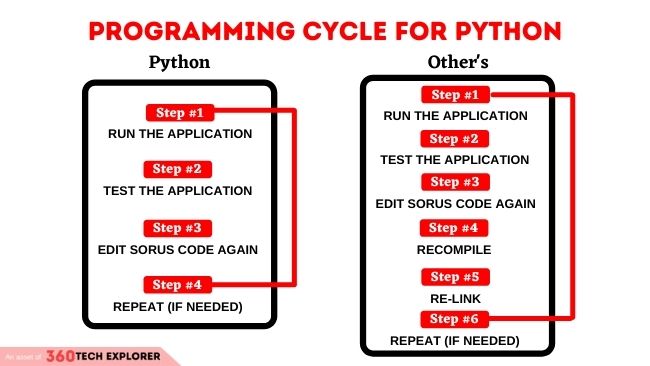Python is a widely-used and popular programming language that has found its way into various industries, making it a go-to tool for developers. One of the reasons behind its wide acceptance is its simplicity and user-friendliness, making it easily accessible for both novice and seasoned programmers. However, like any other programming language, Python also adheres to a programming cycle that programmers must grasp to write efficient and effective code. In this blog post, we will delve into the programming cycle for Python and discuss how it can help improve your programming skills.
Python programming cycle is a little bit different from the traditional programming cycle because, unlike the traditional programming cycle, python does NOT have compile or link steps because of this behavior Python programs run immediately after changes are made. The programming Cycle for Python is in rapid prototyping.
Want to understand the programming cycle of python more deeply? Stay here!
What is the programming cycle?
The programming cycle is the “spiral model” described by Barry Boehm in the 1980s, also referred to as the application development life-cycle, which is a process to design, develop, test, and deploy software. The development cycle aims to produce high-quality software that meets or exceeds customer expectations and reaches completion within times and cost estimates.
The Python programming cycle is a systematic approach to software development that involves several stages. The first stage is problem definition, where developers identify the requirements, constraints, and objectives of the project. In the planning stage, developers create a detailed plan that includes the algorithm, data structures, and technical specifications required to solve the problem.
Following the Python programming cycle can help developers create high-quality programs that are efficient, reliable, and scalable. It is a widely accepted approach to software development that is used in various industries and has proven to be effective in creating robust software solutions.
What is the Programming Cycle for Python?
The development cycle of Python is considerably shorter than that of traditional tools. There is no compilation or linking steps in Python. Python programs simply import modules at runtime and use the objects they contain. Because of this, Python programs run immediately after changes are made. Also because Python is interpreted, there’s a rapid turnaround after program changes. And because Python’s parser is embedded in Python-based systems, it’s easy to modify programs at runtime.


Python is based on C and C++. Python’s core is completely written in a mix of both C and additional C++ Libraries as add-ins such as Qt, Wix, and Win32 among hundreds more.
How well Python can Cycle, just have a look at programs such as DropBox and or Blender Render(with the BE-Game Engine), and are nonetheless massive.
Many fail to recognize that Python executes fully as an already compiled C Language with tie-ins C++ Libraries along with any Language that makes use of the C, C++ Languages argv, argc parsing of the Operating Systems Command-Line through any Shell Program by those likewise.
Traditional programming cycle vs Programming cycle for python
| Python programming cycle | Traditional programming cycle | |
| STEP #1 | RUN THE APPLICATION | RUN THE APPLICATION |
| STEP #2 | TEST THE APPLICATION | TEST THE APPLICATION |
| STEP #3 | EDIT SORUS CODE AGAIN | EDIT SORUS CODE AGAIN |
| STEP #4 | SKIP THIS STEP | RECOMPILE |
| STEP #5 | SKIP THIS STEP | RE-LINK |
| STEP #6 | REPEAT (IF NEEDED) | REPEAT (IF NEEDED) |
In simple terms, the Python development cycle does not have to compile and link steps, unlike the traditional programming cycle.
In conclusion, Python’s simplicity, user-friendliness, and lack of compile and link steps have made it a popular programming language that has found its way into various industries. The Python programming cycle follows a systematic approach to software development that involves several stages, including problem definition, planning, coding, testing, debugging, and maintenance. Following this approach can help developers create high-quality programs that are efficient, reliable, and scalable. The Python development cycle is considerably shorter than that of traditional tools, making it an ideal choice for rapid prototyping. Overall, Python’s programming cycle is a valuable tool that can help improve your programming skills and create effective and efficient software solutions.



1 thought on “Programming Cycle for Python”
amazing concept
you will have a very bright future.